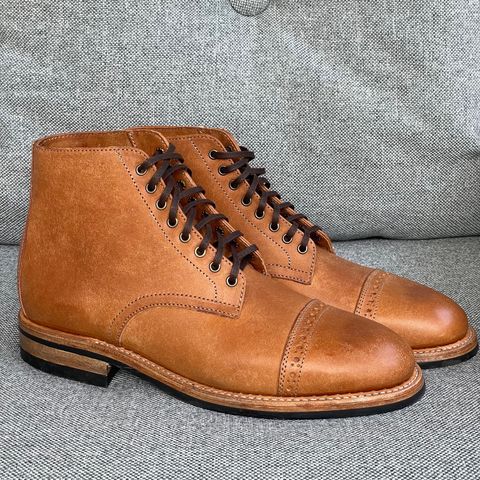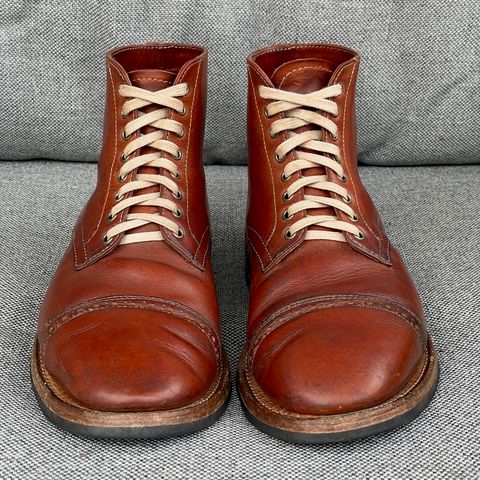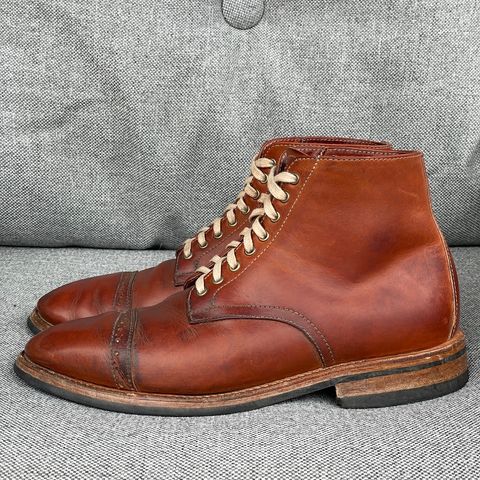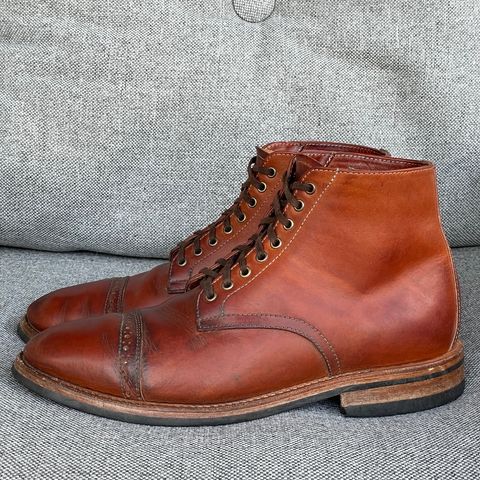Badalassi Carlo Cognac Pueblo Veg Crust
Leather Color • exclusive for Oak Street Bootmakers • variant of Badalassi Carlo Cognac PuebloAbout
Oak Street Bootmakers - Badalassi Carlo Cognac Pueblo Veg Crust is an exclusive variation of Cognac Pueblo leather produced by Badalassi Carlo in San Miniato, Tuscany specifically for Oak Street Bootmakers. The leather features natural tan-brown vegetable crust tones with minimal finishing, allowing extensive customization and patina development. Cognac Veg Crust combines the technical properties of Pueblo leather—including full-grain vegetable tanning and matte stone-ground surface—with a deliberately understated finish that emphasizes natural leather character and rapid color evolution.
About
Oak Street Bootmakers - Badalassi Carlo Cognac Pueblo Veg Crust is an exclusive variation of Cognac Pueblo leather produced by Badalassi Carlo in San Miniato, Tuscany specifically for Oak Street Bootmakers. The leather features natural tan-brown vegetable crust tones with minimal finishing, allowing extensive customization and patina development. Cognac Veg Crust combines the technical properties of Pueblo leather—including full-grain vegetable tanning and matte stone-ground surface—with a deliberately understated finish that emphasizes natural leather character and rapid color evolution.
The Veg Crust designation indicates leather that receives limited finishing after the vegetable tanning and stone-grinding processes, leaving the material in a more natural state compared to standard Cognac Pueblo. This minimal finishing approach allows Oak Street Bootmakers to apply additional treatments or leave the leather to develop patina from its near-natural state, providing flexibility in final appearance while maintaining the characteristic Pueblo texture and aging properties. The exclusive nature of this variation reflects Oak Street Bootmakers' focus on traditional American manufacturing and preference for materials with visible aging characteristics.
Color characteristics
Cognac Pueblo Veg Crust displays natural tan-brown tones characteristic of vegetable-tanned leather with minimal dyeing or finishing. The coloration results from the vegetable tanning process itself rather than heavy dye application, where natural tannins extracted from tree bark interact with the hide structure to create base color. Light transparent aniline dyeing provides subtle cognac undertones while allowing the natural vegetable-tanned appearance to dominate, creating a more muted and organic color compared to fully dyed Cognac Pueblo.
The vegetable tanning foundation and limited finishing contribute to the color's natural appearance, as the leather retains much of the characteristic tan-brown coloring of vegetable crust leather. This understated base proves more variable in initial appearance than fully finished leathers, with natural marks, tannin variations, and hide characteristics highly visible. The minimal finishing means color depth develops primarily through use and aging rather than being established during manufacturing.
Natural marks present in the steerhide appear prominently in Cognac Pueblo Veg Crust due to the limited finishing. These variations—including scratches, wrinkles, grain patterns, and growth marks—form integral parts of the overall appearance and become emphasized as the leather ages. The stone-ground surface treatment creates the characteristic Pueblo texture while the minimal finishing allows the vegetable-tanned base to show through. Color consistency between hides exhibits greater variation than heavily finished leathers, with each hide displaying individual characteristics reflecting its origin and tanning process.
Physical properties
Cognac Pueblo Veg Crust retains core physical characteristics of the Pueblo leather type, including full-grain vegetable-tanned base structure and hand-buffed stone-ground surface, while differing in the extent of finishing applied. The leather exhibits the matte surface with suede-like texture characteristic of Pueblo, resulting from stone-polishing and hand-buffing where iron balls are rolled over the surface. The minimal finishing means the leather retains more of the natural vegetable-tanned characteristics including higher absorbency and more rapid color change compared to heavily finished variations.
The leather shows pronounced pull-up effects where bent or stretched, with the tan-cognac color lightening dramatically in flexed areas to reveal the pale vegetable-tanned base beneath. This pull-up behavior proves more visible in the Veg Crust variation compared to standard Cognac Pueblo due to the lighter base color and limited finishing. The matte finish remains consistent with other Pueblo variations, providing a stone-ground appearance without gloss in its original state.
Weight specifications for Cognac Pueblo Veg Crust match standard Pueblo production at 5 ounces (2mm plus or minus 0.2mm), with medium temper suitable for boot upper construction. The vegetable-tanned base provides natural characteristics including ready absorption of oils, conditioners, and environmental factors. The minimal finishing means the leather accepts treatments and develops patina more readily than heavily finished leathers, allowing for customization through conditioning products or natural aging. The full-grain surface retains maximum natural grain patterns and marks, emphasizing authentic material character.
Applications
Cognac Pueblo Veg Crust finds primary application in Oak Street Bootmakers footwear where the combination of traditional aesthetics, natural material character, and rapid patina development aligns with the company's manufacturing philosophy. The exclusive nature of the material supports Oak Street Bootmakers' positioning as a premium heritage footwear manufacturer using distinctive materials. The leather's minimal finishing and natural appearance suit boots where visible aging and individual character development form key selling points.
The 5-ounce weight provides appropriate structure for boot uppers while maintaining flexibility for comfortable wear and break-in. The material's high absorbency and rapid patina development create boots that show use quickly, appealing to customers who value visible wear as evidence of authentic use and quality construction. The natural tan-brown base color pairs effectively with brass hardware and natural leather midsoles, supporting traditional boot aesthetics.
The minimal finishing allows Oak Street Bootmakers flexibility in how the leather is treated before or after boot construction. Additional conditioning, waxing, or finishing can be applied to achieve specific appearances, or the leather can be left in its natural state to develop patina entirely through wear. This versatility in treatment options provides manufacturing flexibility while maintaining the characteristic Pueblo stone-ground texture and aging properties.
Beyond Oak Street Bootmakers' production, the exclusive nature of Cognac Pueblo Veg Crust limits its availability for other applications. The material's characteristics would suit any leather goods application where natural vegetable-tanned appearance, rapid patina development, and distinctive texture prove desirable, though access remains restricted to Oak Street Bootmakers' relationship with Badalassi Carlo.
Aging and patina development
Cognac Pueblo Veg Crust develops patina extremely rapidly due to the minimal finishing and high absorbency characteristic of vegetable crust leather. The natural tan-brown base color shows wear effects, oil absorption, and environmental exposure creating visible transformation within days of regular use. High-flex areas darken substantially as the leather absorbs oils from skin contact, environmental exposure, and any conditioning products applied, creating rich brown to dark brown tones in handled and flexed sections.
The leather ages primarily through oil absorption and oxidation rather than mechanical wear alone. The minimal finishing means the material readily absorbs skin oils, conditioning products, and environmental factors, with these substances penetrating deep into the leather structure and causing significant color darkening. Flexing and creasing accelerate this process by opening the leather structure and bringing internal areas into contact with oils and air, revealing color changes throughout the material thickness.
Environmental factors affect Cognac Pueblo Veg Crust more dramatically than heavily finished leathers. Sunlight exposure causes oxidation and can create both darkening and color shifts depending on intensity and duration. Moisture exposure darkens the leather substantially, with water marks potentially permanent depending on water quality and drying conditions. This high reactivity to environmental factors contributes to rapid patina development but requires awareness of how different conditions affect appearance.
Natural marks and imperfections present from production become dramatically emphasized through aging in Veg Crust leather. Scratches, grain variations, and texture differences accept oils at different rates than surrounding leather, creating pronounced individualized character. This characteristic makes each item unique, with wear patterns, handling habits, and environmental exposure creating entirely different final appearances from identical starting material.
Regular buffing with a dry cloth accelerates the burnishing process, transforming the original matte stone-ground finish to glossy patina in frequently handled areas. The minimal finishing allows this burnishing to develop quickly, with high-contact areas achieving mirror-like shine within weeks of regular buffing. The contrast between burnished and unburnished sections creates visual depth and clearly shows use history.
Care and maintenance
Cognac Pueblo Veg Crust requires different maintenance approach than heavily finished leathers due to high absorbency and minimal protective finishing. The leather readily accepts conditioning products, with even light application causing significant darkening and appearance changes. Users should test any products on inconspicuous areas first to understand effects before treating visible surfaces. Natural leather creams and waxes prove appropriate for conditioning when needed, applied sparingly and buffed thoroughly to avoid uneven darkening.
The minimal finishing means the leather shows water, oils, and dirt readily, with stains potentially permanent depending on the substance and how quickly they are addressed. This characteristic forms part of the leather's intended character development rather than representing a defect, with many users valuing the authentic wear evidence. Attempting to prevent all marking through aggressive protection interferes with natural patina development and contradicts the material's designed purpose.
Light cleaning with slightly damp cloth removes surface dirt without excessive wetting. The high absorbency means thorough wetting should be avoided, as water exposure causes substantial darkening that may not lighten completely upon drying. If significant wetting occurs, allowing natural air drying at room temperature proves essential, with forced drying through heat potentially affecting leather temper and causing uneven color development.
The rapid patina development characteristic of Cognac Pueblo Veg Crust means conditioning should be minimal and infrequent. Over-conditioning accelerates darkening to the point where the leather may become nearly black in heavily treated areas, eliminating color variation and natural aging patterns. Most users find the leather requires little to no conditioning beyond what it receives through skin contact and natural oils during regular wear.
Regular dry buffing with soft cloth provides the most beneficial maintenance for Cognac Pueblo Veg Crust. This mechanical action burnishes the surface, accelerating shine development while distributing any surface oils evenly. The buffing requires no products and creates the characteristic glossy patina associated with aged vegetable-tanned leather. The goal of maintenance centers on structural preservation while allowing natural aging, supporting rather than controlling the material's evolution through use.
References
"Badalassi Carlo Tannery Profile". Genuine Italian Vegetable Tanned Leather Consortium. Retrieved October 30, 2025.
"Oak Street Bootmakers - About". Oak Street Bootmakers. Retrieved October 30, 2025.
"Badalassi Carlo - Pueblo - Veg Tanned Leather". Rocky Mountain Leather Supply. Retrieved October 30, 2025.
"Pueblo Leather from Badalassi Carlo Tannery". Delugs. Retrieved October 30, 2025.
























































